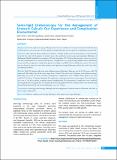Please use this identifier to cite or link to this item:
https://hdl.handle.net/20.500.14356/1392| Title: | Semi-rigid Ureteroscopy for the Management of Ureteric Calculi: Our Experience and Complication Encountered |
| Authors: | Tiwari, Kabir Upadhaya, Amit Mani Kuwar, Ashok Shrestha, Sanjesh Bhakta |
| Citation: | TiwariK., UpadhayaA. M., KuwarA., & ShresthaS. B. (2019). Semi-rigid Ureteroscopy for the Management of Ureteric Calculi: Our Experience and Complication Encountered. Journal of Nepal Health Research Council, 17(2), 233-237. https://doi.org/10.33314/jnhrc.v0i0.1696 |
| Issue Date: | 2019 |
| Publisher: | Nepal Health Research Council |
| Article Type: | Original Article |
| Keywords: | Ureteric calculus Ureteroscopic lithotripsy Semi-rigid ureteroscopy lithotripsy |
| Series/Report no.: | Apr-June, 2019;1696 |
| Abstract: | Abstract Background: Semi-rigid ureteroscopy lithotripsy have become standard of treatment for ureteral calculi. The aim of this study isto review outcome of Semi-rigidureteroscopy lithotripsy and to report the complications encountered. Methods: After approval from institutional committee of Public Health Concern Trust Nepal,we retrospectively reviewed the chart of all patients of ureteral stone who underwent ureteroscopy and pneumatic lithotripsy at Kathmandu Model Hospital between January 2013 and September 2017. Patient characteristics, stone size, success rate and complications were assessed. Intraoperative complications were graded using modified Satava classification system and the postoperative complications graded according to modified Clavien classification system. The success rate was based on stone free status after primary semi-rigid ureteroscopy lithotripsy, without the need of any other secondary procedures. Results: Total 232 patients underwent semi-rigidureteroscopy lithotripsy. Mean age was 46 (16-76) years, with 128 males and 104 females. Size of the stone ranges from 5-18mm. The success rate of primary semi-rigidureteroscopy lithotripsy was in218 (93.9%) cases.Most intraoperative complications were modified Satava grade I (41.7%) andII(3.87%).Four(1.7%) patient had grade III complication, requiring conversion to open surgery. Ureteral avulsion was seen in 1(0.43%) patient, requiring ureteral reimplantation.The postoperative complication were modified Clavien grade I(10.7%), grade II(5.17%), grade III (4.6%) and grade IV(0.43%). Double J stents were inserted in all the patients postoperatively.The mean hospital stay was 2.2(1-14)days. Conclusions: Semi-rigid ureteroscopy lithotripsy for the management of ureteral stones is efficacious and have a lesser major complications. Keywords: Ureteric calculus; ureteroscopic lithotripsy; Semi-rigid ureteroscopy lithotripsy |
| Description: | Original Article |
| URI: | http://103.69.126.140:8080/handle/20.500.14356/1392 |
| ISSN: | Print ISSN: 1727-5482; Online ISSN: 1999-6217 |
| Appears in Collections: | Vol. 17 No. 2 Issue 43 Apr - Jun 2019 |
Files in This Item:
| File | Description | Size | Format | |
|---|---|---|---|---|
| 1696-Manuscript-10751-1-10-20190804.pdf | Fulltext Download | 222.9 kB | Adobe PDF |  View/Open |
Items in DSpace are protected by copyright, with all rights reserved, unless otherwise indicated.
